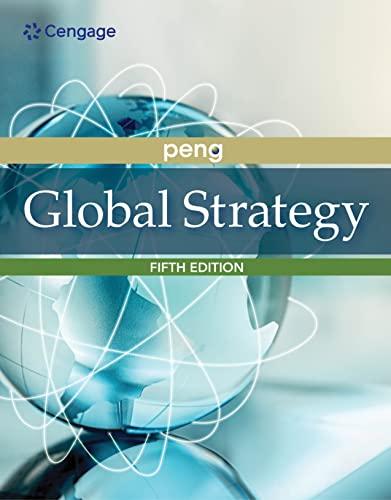The Chinese economy slows down is one of the leading themes in global business news. Foreign firms
Question:
“The Chinese economy slows down” is one of the leading themes in global business news. Foreign firms interested in the legendary “one billion customers” are advised to adjust their high-flying expectations down to Earth.
Defying this trend, business jet makers continue to have skyhigh expectations for China—for a good reason. Arriving in China as recently as in 2003, this industry is literally just “taking off.” Business jets (also known as corporate jets or private jets) are ideal for China, which has a vast territory good for flying—the third largest in the world behind Russia and Canada. China has also amassed the world’s second largest number of billionaires (behind the United States) and is rapidly churning out new ones who can afford to buy jets. Yet, only fewer than 400 business jets currently fly in China, a number that is not only smaller than the number in Brazil and Mexico, but also smaller than what can be found in one single airport in the United States—Orange County airport outside Los Angeles.
Institutions The rise of China for business aviation also coincides with the aftermath of the 2008 global financial crisis, during which many buyers canceled their orders. It is not surprising that anybody who is somebody in business aviation is eager to elbow its way into essentially the virgin skies of China. But here is an institution-based catch. The skies in China are formally controlled by the military, and flight plans have to be submitted via a cumbersome process.
Beijing’s airport only gives two takeoff slots an hour to business jets. Buyers importing jets are hit by onerous duties and taxes, and officials have talked about slapping a new luxury tax on top of those. Further, an anticorruption (and anticonspicuous consumption) campaign unleashed by President Xi Jinping has scared away a lot of large stateowned enterprises (SOEs), which used to make up approximately 15% of the business jet market in China. SOEs now buy only about 5%.
While institution-based barriers persist, the government has offered a glimmer of hope. It seems to have realized the value of business aviation. The latest five-year plan explicitly calls for the development of non-airline aviation, and the military is instructed to give up some chunks of air space to leave room for business jets. The industry, of course, has been marketing and lobbying intensely, claiming that business aviation is not merely a luxury, but also a productivity booster that can propel firms’ (and China’s) growth to new heights.
Resources and Capabilities Leveraging resources and capabilities, each business jet maker is endeavoring to outshine the others. Beech Hawker, Cessna, and Gulfstream of the United States, Dassault Falcon of France, and Learjet of Canada (owned by Bombardier)
are the traditional competitors. Each carries eight to 12 passengers and offers privacy, luxury, and often very long range flight capabilities. Salivating over growth potential, the top three larger jet makers—Boeing, Airbus, and Embraer (of Brazil)—have also entered the fray.
Boeing adapted its 737 to offer the Boeing Business Jet (up to 60 passengers). Airbus modified its A320 to launch the Airbus Corporate Jet (up to 40 passengers). Embraer turned its ERJ 190 regional jet into Lineage 1000 (up to 20 passengers). These ultralarge business jets offer more spacious interiors, better air circulation (due to their larger cabin), and longer range—at price points competitive with those of the traditional business jets.
In China, the current market leader is Gulfstream, which has sold more than 100 jets and holds the biggest market share. Gulfstream does whatever it takes to win orders, including changing the model number instead of offending potential buyers with an unintended meaning. Specifically, in 2011, Gulfstream renamed its G250 introduced in 2008 to G280. Its website explained: “As demand for Gulfstream business jets grows around the world, the move was prompted by the company’s sensitivity to the varied cultures of its international customer base.” While it never explained exactly why, it was because “250” means “stupid” or “useless” in some parts of northern China. One senior executive explained to the press that “we determined that G280 is a more amenable number sequence in certain cultures.”
Such market-oriented efforts have been handsomely rewarded by eager Chinese customers. In April 2014 at the Asian Business Aviation Conference and Exhibition in Shanghai—a major industry gathering—Gulfstream signed a 60-plane deal with Minsheng Financial Leasing, the aviation-finance arm of a major private bank in China.
This is not only one of the largest deals for Gulfstream, but also one of the largest worldwide.
As the industry takes off, rising signs of sophistication emerge. A decade ago, the first Chinese buyers tended to pay cash and flew rarely—only to impress friends. Today’s buyers often take advantage of financing or leasing (as evidenced by the Gulfstream–Minsheng deal). They fly more and endeavor to get more bang out of their bucks. Some of them cannot wait one to two years, so they have done something unthinkable for the superrich: buying used jets. Experts estimate that in the next 20 years, demand in China will be the third largest in the world, resulting in 1,500 business jets— behind 9,500 in the United States and 4,000 in Europe.
Case Discussion Questions
1. Why are business jet makers so eager to enter China?
2. From an institution-based view, what needs to be done to enhance the prospects of this industry in China?
3. From a resource-based view, what does it take to win in China?
4. ON ETHICS: As CEO of a business jet maker in the United States who is eager to sell more planes to China, you are going to meet with a senator who is famous for advocating a policy of “decoupling from China.” What are you going to say to her?
Step by Step Answer:






